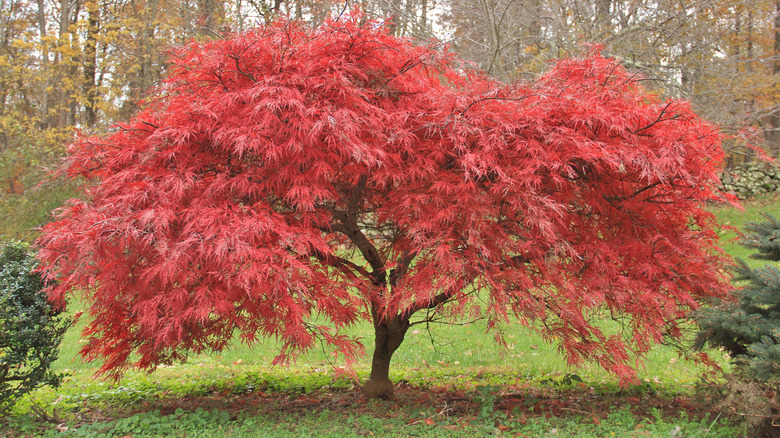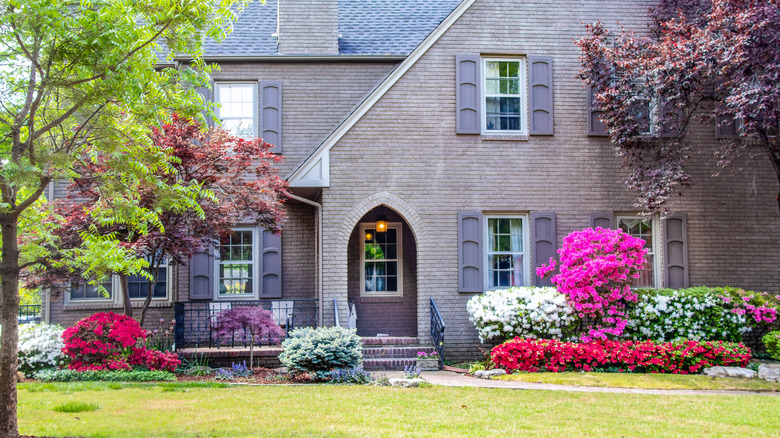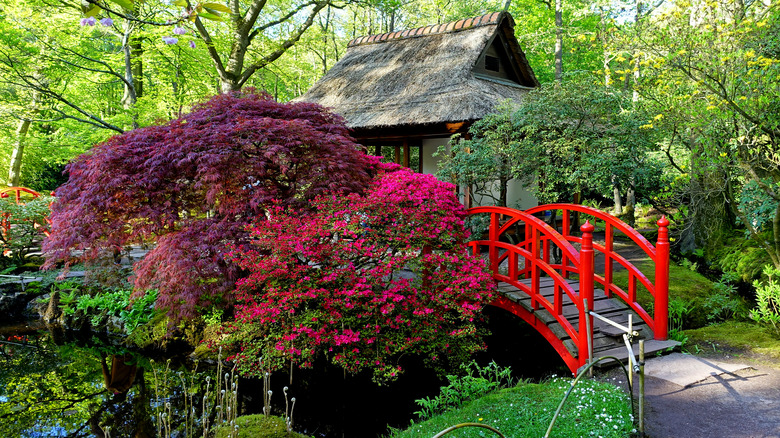Grow This Gorgeous Flowering Plant Near Your Japanese Maple For Vibrant Color
When you want to add color, vibrance, and stunning elements to your garden and landscapes, consider the benefits of incorporating different types of plants near each other. Whether they diverge starkly in color, texture, or height or possess complementary elements, variety helps to make the space visually interesting. For example, if you have a Japanese maple (Acer palmatum) already making a statement, you can add the beautiful color variety of azaleas to the area.
Azaleas come in numerous shades and styles but often have bright, gorgeous blooms that can infuse much beauty with textural and visual qualities into any landscape. During the winter, azaleas compliment the Japanese maple with structural elements, especially if you choose evergreen types. The Japanese maple, a smaller deciduous tree or, in some forms, a larger shrub, tends to have layered branches and can reach as high as 25 feet. Depending on species selection, some azaleas can be quite large, too, pairing well with a Japanese maple opposite it in a flowerbed.
Azaleas and Japanese maples need the same basic conditions to thrive, including sunlight, moisture, and nutrients, making them excellent companion plants. Though both come in different species variations, they can work well together overall and create a mesmerizing landscape. To achieve success with both of these plants, there are a few key considerations.
The ideal environment for Japanese maples and azaleas
Both Japanese maples and azaleas benefit from a shared environment. However, you'll need to choose varieties that thrive under similar circumstances. For example, like the Japanese maple, most azaleas benefit from acidic soil. Adding organic matter can help ensure your soil is acidic enough. Both plants' growth rate is better with the support of ample organic matter.
The soil also needs to be well drained. Azaleas have hair-like roots that spread into the soil's upper layers and do not do well when sitting in water for too long. On the other hand, those roots are so small that the soil needs to be loose and easy to move through. Japanese maples are a bit heartier because they have a deeper root system, but as a slow-growing plant, they, too, benefit when it's easy for root systems to expand.
The next consideration is the amount of sunlight these plants need. Azaleas benefit from full sun to partial shade. They are more likely to suffer damage to their leaves if they are in the hot summer sun for more than four hours a day, though. When planted in the shade, they tend to spread out more as their branches seek sunlight and remain more compact in areas with more sun. Japanese maples also don't thrive in full sun for long periods, especially in high temperatures. They do best in a partially shaded area, like near the house.
Supporting the growth of both plants in the same environment
Japanese maples and azaleas do well when planted from seedlings or larger plants. Once planted, keep the soil moist but not saturated continuously. Most of the time, Japanese maples don't require much maintenance, though structural pruning is helpful to keep them healthy and control their growth. A key to pruning is to keep inner branches from rubbing on each other and remove any new growth that points inward.
Both plants benefit from feeding throughout the warmer months, especially once before the flowering season and again after the blooms come in. Organic fertilizers tend to be best here. Once your Japanese maple is established, you can fertilize it right before the leaves emerge to give it more of the boost it needs. As long as the soil is nutrient-rich with organic matter, most maples don't require additional nutrients from feedings.
Monitor both plants for pest infestations in your garden. Though Japanese maples tend to be relatively insect- and disease-free, they can develop in an area where uncontrolled pests are common. Azaleas are more prone to pest infestations, especially whiteflies. Natural pest control can work well. Don't be afraid to add more azaleas to your Japanese maple flowerbed. Consider a few different color options, and you can trim flowers to bring into your home all season long.


